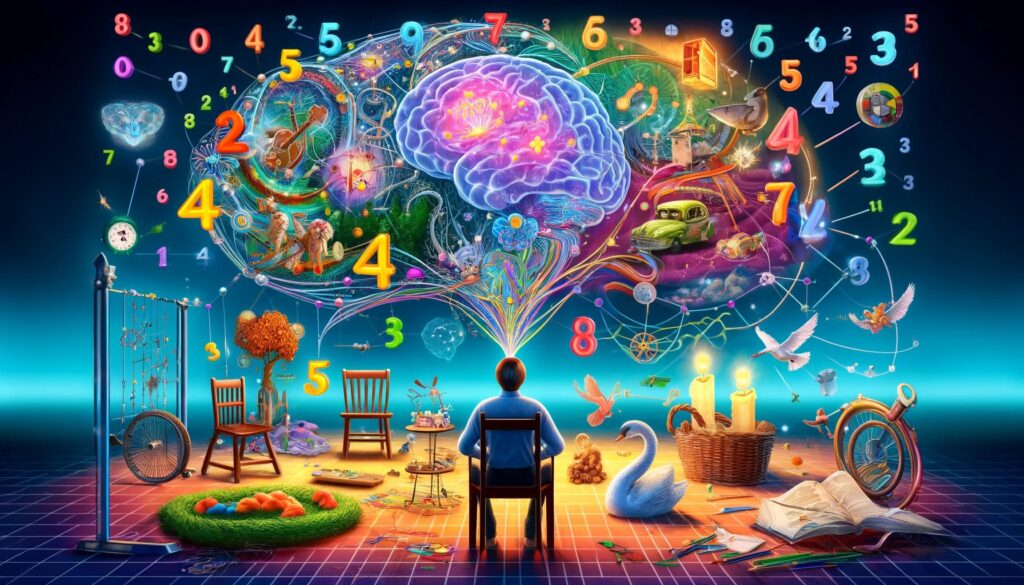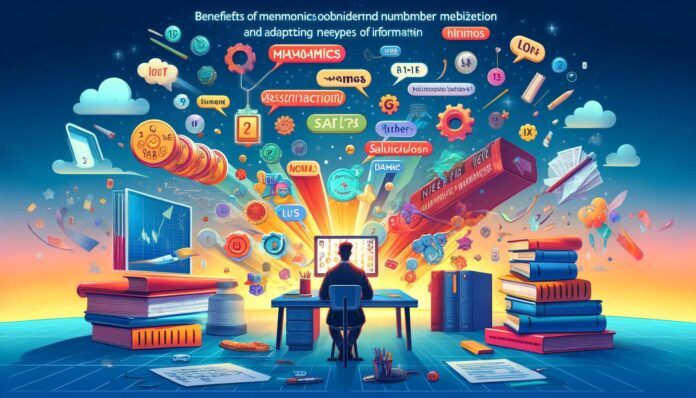In today’s demanding, fast life, information retention is a virtue worth its weight in gold. It becomes an important skill when data keeps flowing at a very incomparable rate, and thus, memory techniques can improve our cognitive capability. Mnemonics, one of the most effective memorizing methods for building a better memory, is an elaborate way to give new items a familiar aspect.
Whether you’re a student pursuing your education, a professional in the working world, or a reader of The New York Times (NYT), taking advantage of mnemonic strategies can make your daily tasks easier. Through the knowledge you get from these methods, you can remember the critical aspects of interactions, which makes communication meaningful and productive. Mnemonics are founded on the fact that our brain naturally gravitates towards patterns and associations, and thus, memorization is made easier by converting it into striking pictures.
This article(four digits to memorize nyt) is about memory mnemonics and how they are specifically helpful in four-digit number learning, a typical but often forgotten task. By working on different examples and getting more and more acquainted with their detailed explanations, you will gradually internalize the technique of Mnemonics into your arsenal of memorizing tools.
The Value of Memory Retention in an Information-Heavy World
Today’s world, overwhelmed by information, has made memorizing important facts even more critical. The abundance of data from different sources makes us feel bombarded with information, which overwhelms us. However, good short-term memory retention can contribute to better information processing. Recalling pertinent details gives you an edge in academic, professional, or casual reading.
For the NY T readers, there is adequate memory of significant dates, information, and events, which stimulates understanding and interaction with the content. When we retain memory, it doesn’t just work about keeping the information for its own sake. Instead, it interprets the connections, perceives the patterns, and understands the context. This is the most crucial skill for handling the modern complexities of the world.
Mnemonics contribute to improving memory retention as they enable learners to associate abstract numbers and facts with numerous visual images. This remodeling gives a feeling of ease of remembering information when required, which provides assurance and supremacy over data you meet daily.
Why Memorizing Four-Digit Numbers is Challenging
Memorizing four-digit numbers presents a unique challenge for many people. Unlike words or images, numbers lack inherent meaning, making them harder to remember. Our brains are naturally inclined to recognize and retain patterns and associations, but numbers often seem arbitrary and disconnected. As a result of this utterly random sequence without context, it will become challenging to remember a particular set of digits. As an illustration, 1987 will be more easily remembered when associated with an important event rather than just a randomly picked number.
By contrast, numbers like 4732 are much more challenging to recall. The level of complexity increases with the length of time since our short-term memory has a minimal capacity for storing information. This is where mnemonic strategies become of fundamental importance. Through association and pattern formation, mnemonics fill the gap separating numbers from memorable and meaningful content that can be retained.
With the help of your imagination and creative thinking, the four-digit numbers will be turned into less complex and more accessible representations of them to remember. Thus, the challenging task will change into a simple one.
The Science Behind Mnemonics: Patterns and Associations
Mnemonics, along with tapping the natural capabilities of your brain to recognize patterns and form associations, function the same way as well. Our brain’s functions are accustomed to linking new information and our existing knowledge. That is the magic of this technique- the capacity to relate different fragments into a unity. We apply mnemonics to change from jumbled information into known and meaningful ones. For instance, we express numbers in the form of pictures or words, which are more memorable and utilize a more robust brain’s visual or linguistic knowledge in comparison to figures.
Cognitive psychologists have found that applying memory techniques can effectively improve learning performance. By exploiting the brain’s capabilities, mnemonics discharge the memory-recalling pressure associated with these processes. This participatory imprinting process on long-term memory serves the purpose of making all the stored data more available.
Vivid Mental Images for Number Retention
Significantly, one can use mentally vivid pictures as mnemonic techniques to remember numbers. The human brain, however, remembers pictures more easily than numbers because pictures can incorporate emotions, experiences, and different forms of knowledge. To use this technique, match every number entirely with a unique and impressive picture. You could connect the written number 1 to a drawn candle, 2 to a swan, 3 to a trident, etc. As soon as you have formed these links, you can imagine a movie that associates these images in your mind and number them the way you want them to be. Take, for instance, number 1234.
If you were trying to remember it, you would imagine a candle lighting up a swan that then uses a trident to open a door (4). This strategy changes esoteric number sequences into concrete, interrelated images and lowers their memorization intensity. By memorizing four-digit numbers, your power of remembering becomes solid and straightforward for you.

Associating Numbers with Memorable Pictures
Associating numbers with memorable pictures involves a systematic approach that can turn abstract digits into easily recalled images. Start by creating a list of images related to each number from 0 to 9. For instance, you could use a candle for 1, a swan for 2, a trident for 3, a chair for 4, and so on. Ensure these images are vivid and distinctive to facilitate easy recall. Next, practice linking these images to form a coherent mental story. Take a four-digit number, like 5678, and visualize the sequence: imagine a glove (5), picking up dice (6), then throwing them into a rainbow (7), which ends in a snowman (8).
This visual narrative makes the number more memorable. Regularly practicing this technique helps reinforce the associations and improves recall. Additionally, this method can be applied in different contexts to enhance its effectiveness. For instance, try using it with other information or in various situations, such as remembering phone numbers, dates, or statistics from your NYT readings.
Incorporating Mnemonics into Daily Reading Habits
As part of your daily reading habits, mnemonics can remarkably augment your memory retention and comprehension. First, consider what information is essential to memorize, mainly dates, statistics, and important events. Make visual or amputated images or associations for these small details. To illustrate, turn a random four-digit number into an exciting picture or story if you encounter it when reading an NYT magazine. Put this technique into practice regularly so that it becomes your daily routine. In addition to attending lectures, you should be on the constant lookout to practice mnemonic tricks as you read.
This might happen through creating images of numbers, associating them with nearby objects, or building mental stories to connect all the information. With the help of mnemonics, you can remember the details long after reading the text, enhancing memory abilities. Beyond this, if you are trained often, using them in any situation becomes automatic and effortless. Apart from strengthening your memory, this habit will immensely help enhance your approach to enrich your reading experience.
Using Mnemonics on NYT Content
Using mnemonics in the context of NYT material helps make the whole thing interactive and understandable. For example, say you viewed a story about a historical event 1969. Here, 1 stands for a candle, 9 is a balloon, and the second 9 is for a giant balloon, too. Picture a candle a balloon is lit by, then hit with a golf club, sending it into another balloon. The sharp, detailed imagery that this generates allows me to remember it effortlessly. Also, you can similarly encounter a statistic such as 3,478. You can break this down into shorter bits and establish associative relationships with every digit.
Visualize a trident (3) across to a chair (4), which is then knocked down by a dice (7) and into a snowman (8). Applying these techniques to passages you pick from your reading material shall solidify the mnemonic associations in your brain, making progression faster. This method makes abstract numbers concrete, accurate, and easy to remember. This makes the learner retain better what they have learned.
Remembering Election Results with Mnemonics
Consider a case study involving the memorization of election results. Suppose you read an NYT article about a historic presidential election where the winning candidate secured 306 electoral votes. To remember this number, you could use mnemonic associations such as visualizing three balloons (3) floating in the sky, each displaying the candidate’s campaign logo. Then, picture a massive stadium (0) with a podium at its center, symbolizing an election event. Finally, imagine six enthusiastic voters (6) waving flags supporting the successful candidate.
Combining these images into a single mental picture creates a vivid and memorable story that helps you recall the number 306 effortlessly. This method can be applied to any significant number you encounter, making remembering crucial details from articles and reports easier. By using mnemonic techniques, you can enhance your understanding and arrangement of the material, making critical information more accessible and memorable.

Turning Numbers into Stories
Visualization is a very efficient tool for transforming abstract figures into meaningful stories. Narratives, which our brains store better than isolated facts, justify using this method. To bring in visualization, begin by converting the numbers into images of the associated digits. Afterward, take these pictures and link them to produce a story that is comprehensible and spectacular. For instance, for the number 4812, picture a chair a snowman uses to reach taller shelves where a candle is kept along with a swan.
Thus, The story makes a series of images easy to port in memory rather than the digits. Visualization should not be limited, but all entities should be as realistic and specified as possible. The more profound the sense of memory, the more emotions and minds you will engage; the more robust the memory will be. Consistently applying this technique for creating and recalling mental stories will enable you to develop a better memory. This will help you process the vital information that matters in the brain.
Key to Mastering Mnemonic Techniques
Regular practice is essential for mastering mnemonic techniques. Like any skill, memory improvement requires consistent effort and application. Start by incorporating mnemonic exercises into your daily routine. Set aside a few minutes daily to practice creating and recalling mnemonic associations. Use real-world examples, such as numbers and details from your NYT readings, to make the practice relevant and practical. As you become more comfortable with the techniques, challenge yourself with more complex information.
Review and reinforce your associations regularly to remain robust and easily accessible. Over time, this consistent practice will make mnemonic techniques a natural part of your cognitive toolkit. You’ll find that recalling information becomes faster and more effortless, enhancing your overall memory retention and mental abilities. By making mnemonic practice a regular habit, you can unlock the whole possibility of your memory, making it easier to remember and recall essential details in any context.
Adapting Mnemonics to Different Types of Information
Mnemonics are flexible, and this finesse allows them to be applied to memorizing information. Statistics occur when numbers stand out; however, they also apply to using words, dates, lists, etc. Therefore, a list-wise mental image will help you gradually remember a set of items in the sequence. In the case of dates, relationships can be achieved by associating each part of the month with an image or a narrative combined into a compelling story.
Also comparable, for words or phrases, you can form connections with the meaning or pronunciation of the words the same way. Mnemonics techniques can be modified to every type of information, thus increasing memory retention and overall recall & recollection skills. This versatility is one of the indispensable tools for one who wants to use them to improve his cognitive skills. As you get used to applying them and practicing, they will be handy to you in remembering information and keeping it in your mind, facilitating your daily life activities.
Overcoming Common Challenges in Number Memorization
Memorizing numbers can be challenging due to their abstract nature, but several strategies can help overcome these difficulties. One common challenge is the lack of inherent meaning in numbers, which makes them harder to remember. To deal with this, try some mnemonics that help create associations and patterns with the numbers, giving them more context and importance. Another problem is short-term memory capacity, which is very limited and may cause difficulties in remembering a long series of digits. Break into smaller units and embed mnemonics tools for each chunk to avoid big tasks.
Furthermore, these routes of memory should be done often and repeatedly to foster long-term associations and retrieve memory items better. If you find a specific number challenging to remember, try creating more intense images and associating them with something personal rather than just numbers. Conquering the pesky issue of memorizing and recalling numbers can be as simple as regularly using the appropriate procedures and mnemonic devices. This way, you can translate this complex task into a walk in the park.

Benefits of Mnemonics Beyond Number Memorization
The benefits of mnemonics extend far beyond number memorization. Learning and using these methods can improve general cognitive functioning, such as learning a language, studying, and daily life activities. You can quickly recollect names, dates, and lists through mnemonics, saving time and removing your worries. In academic settings, the learning of mnemonics allows members to recall complicated information and enhance academic performance. Employees can use these techniques in professional environments to remember essential details and to improve productivity. Mnemonics also boost creativity and problem-solving skills by encouraging you to think in new and innovative ways.
Additionally, mnemonics can improve focus and concentration, as creating vivid mental images requires active engagement with the material. Overall, the versatility and effectiveness of mnemonics make them a valuable tool for anyone looking to enhance their memory and cognitive abilities. By integrating these techniques into your daily practice, you can unlock the full potential of your memory and improve your performance in various areas of life.
Conclusion
Integrating mnemonic strategies into your reading habits can transform how you approach and retain information in publications like The New York Times. By leveraging the power of imagination and association, you can unlock the true potential of your memory, making it easier to remember four-digit numbers and other critical details. The techniques discussed in this article, such as creating vivid mental images, forming associations, and practicing regularly, can significantly enhance your memory retention and recall abilities. These strategies make memorizing numbers more manageable and enrich your reading experience, allowing you to engage more deeply with the content. Whether you are:
- A student.
- Professional or casual reader.
- Incorporating mnemonics into your routine can simplify your life and improve your cognitive abilities.
Turning abstract numbers into memorable stories can make the information more accessible and meaningful, ensuring you never forget essential details from your readings. Start practicing these techniques today to unlock the full potential of your memory.
Also Read About: Unveiling the World of News Reporter 7.5: The Frat Boy Photographer
FAQ’s
Why should I memorize four digits to memorize NYT as an NYT reader?
Memorizing four-digit numbers can enhance your reading experience by helping you retain critical dates, statistics, and other numerical figures mentioned in New York Times articles. This skill allows you to understand the content better and actively engage in discussions about the topics covered. Improved memory retention can also make reading more enjoyable and fulfilling, as you can recall essential details more easily.
Are there any particular methods I should use to remember numbers and memorize NYT?
Yes, mnemonic techniques can significantly aid in memorizing four-digit numbers. One effective method is associating each digit with a memorable image or word and creating vivid mental images that link these items together. Additionally, breaking the number into smaller, meaningful segments, known as chunks, can simplify memorization. These strategies leverage the brain’s natural affinity for patterns and associations, making recalling numbers easier.
How much time and effort must I invest in mastering four-digit memorization techniques?
The time required to master four-digit memorization techniques varies for each individual. However, regular practice and experimenting with different methods are crucial for success. Set aside specific times for mnemonic exercises and apply these techniques in practical, everyday situations, such as remembering numbers from NYT articles. Your memorizing skills will gradually improve with consistent effort and perseverance.
Can I apply mnemonic techniques to remember other types of information besides four-digit numbers?
Mnemonic techniques are versatile tools that can be used to remember various types of information, including names, dates, vocabulary, and more. By understanding the wide range of their application, you can feel inspired and motivated to use these techniques in different contexts. This will enhance your memory retention abilities and make your intellectual journey more enjoyable, as you can recall diverse information more easily.
How can I maintain the effectiveness of my memorization skills over the long term?
Maintaining the effectiveness of your memorization skills requires regular review and reinforcement of what you have learned. Practice schedules that include spaced repetition and periodic recall tests can help strengthen neural connections, preventing decay. Additionally, staying open to new opportunities that challenge or expand your memory abilities is essential. For example, engaging in discussions about various topics covered by The New York Times or reading a wide range of issues can keep your memorization skills sharp and effective over the long term.



